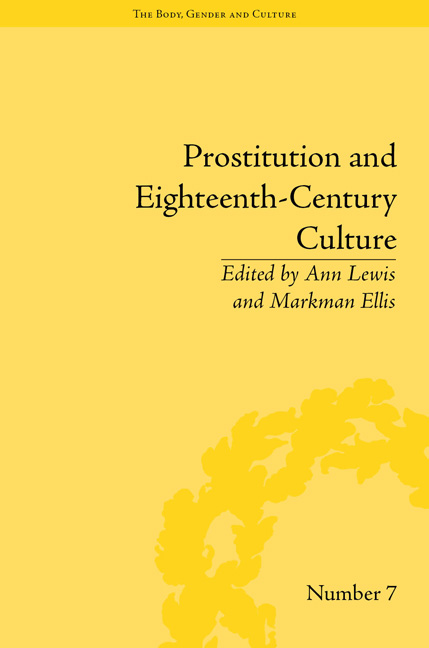Book contents
- Frontmatter
- CONTENTS
- Acknowledgements
- List of Contributors
- List of Figures and Tables
- Introduction: Venal Bodies – Prostitutes and Eighteenth-Century Culture
- Part I (Auto)Biographical and Classificatory Fictions: Madams, Courtesans, Whores
- Part II Visibility and Theatricality: Fiction, Image and Performance
- 6 Prostitutes and Erotic Performances in Eighteenth-Century Paris
- 7 Visible Prostitutes: Mandeville, Hogarth and ‘A Harlot's Progress’
- 8 The Narrative Sources of Candide's Paquette
- 9 The Prostitute as Neo-Manager: Sade's Juliette and the New Spirit of Capitalism
- Part III The Magdalen House: Marriage, Motherhood, Social Reintegration
- Part IV Wider Perspectives: Constructing the Prostitute in Social History
- Notes
- Index
8 - The Narrative Sources of Candide's Paquette
from Part II - Visibility and Theatricality: Fiction, Image and Performance
- Frontmatter
- CONTENTS
- Acknowledgements
- List of Contributors
- List of Figures and Tables
- Introduction: Venal Bodies – Prostitutes and Eighteenth-Century Culture
- Part I (Auto)Biographical and Classificatory Fictions: Madams, Courtesans, Whores
- Part II Visibility and Theatricality: Fiction, Image and Performance
- 6 Prostitutes and Erotic Performances in Eighteenth-Century Paris
- 7 Visible Prostitutes: Mandeville, Hogarth and ‘A Harlot's Progress’
- 8 The Narrative Sources of Candide's Paquette
- 9 The Prostitute as Neo-Manager: Sade's Juliette and the New Spirit of Capitalism
- Part III The Magdalen House: Marriage, Motherhood, Social Reintegration
- Part IV Wider Perspectives: Constructing the Prostitute in Social History
- Notes
- Index
Summary
Paquette is a minor character in Voltaire's Candide who makes just four appearances in the novel, the first as part of the doomed world of Thunder-ten-tronckh, destroyed and then miraculously, if only partially, reconstituted in the novel's final chapter. In Chapter 4, Pangloss wonders aloud whether Paquette is still alive. She is, and her reappearance in Chapter 24 allows the telling of her unhappy life as a prostitute. Paquette then recedes from the forefront of Candide and is thereafter referred to only in the third person. In line with the tale's moral purpose, we learn in Chapter 30 that she has abandoned the ‘trade’ and has taken up embroidery instead!
In 1960, J. H. Broome argued that the character of Paquette was inspired by the eponymous heroine of Fougeret de Monbron's best-known work, the erotic novel Margot la Ravaudeuse: histoire d'une prostituée (1750).3 Broome highlighted a number of verbal and narrative parallels linking Margot's adventures to Paquette's life-story as told in the fifty lines Candide devotes to her saga.4
For instance, he pointed out that Paquette recounts her seduction by a monk; Margot has a similar experience with a Carmelite. Paquette becomes a doctor's mistress, is imprisoned, and freed by a judge. Margot is also imprisoned, and liberated by a président. Broome noted that Voltaire would have endorsed Monbron's vigorous denunciation of the social evils associated with prostitution.
- Type
- Chapter
- Information
- Prostitution and Eighteenth-Century CultureSex, Commerce and Morality, pp. 115 - 126Publisher: Pickering & ChattoFirst published in: 2014



